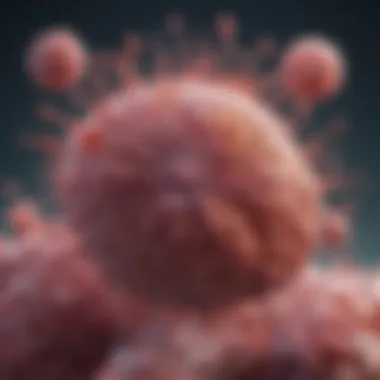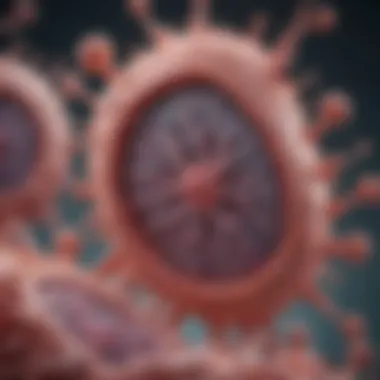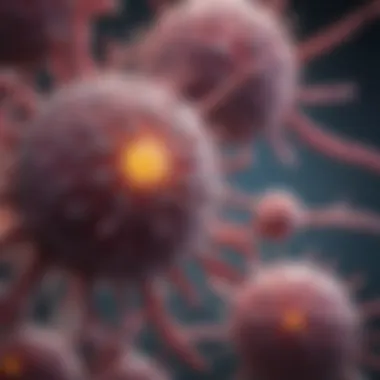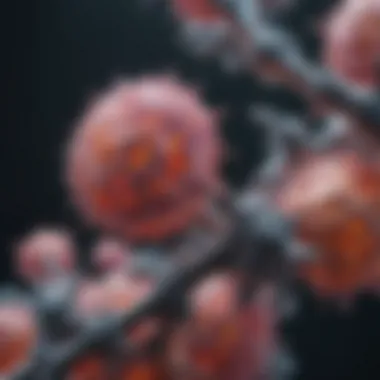Exploring BRCA1's Role in Cancer Mechanisms


Intro
The BRCA1 gene is an integral part of genomic stability and plays a vital role in the body’s ability to repair DNA damage. Mutations in this gene have profound implications, particularly in increasing the risk of breast and ovarian cancers. Understanding the mechanisms underlying BRCA1's function provides crucial insights into cancer biology. This comprehension can lead to improved diagnostics and potential therapeutic strategies.
In this article, we will explore how BRCA1 mutations contribute to tumorigenesis, delve into the gene's fundamental involvement in DNA repair mechanisms, and discuss the consequences of its dysfunction on various cellular processes. Every aspect underscores the importance of genetic screening and the promising future of targeted therapies for individuals harboring these mutations.
Methodology
Overview of Research Methods Used
To elucidate the mechanisms of BRCA1 in cancer development, this article examines a range of research methodologies. Primarily, extensive literature reviews and meta-analyses of existing studies were utilized to consolidate knowledge. This approach provides a broad perspective on how BRCA1 mutations influence tumor behavior and progression.
Experimental studies from peer-reviewed journals also play an important role. They contribute empirical data to support theoretical claims regarding the functionality of BRCA1. Both in vivo and in vitro studies enable researchers to observe the impacts of BRCA1 alterations directly.
Data Collection Techniques
Data collection involved several techniques:
- Genomic sequencing: This helps identify BRCA1 mutations and variants among patients.
- Cell line experiments: These provide evidence of BRCA1's role in cell cycle regulation and DNA repair.
- Patient registries: Surveys and databases of individuals with BRCA1 mutations provide valuable clinical outcomes data.
By integrating these approaches, researchers can develop a well-rounded understanding of BRCA1's function and the pathways it influences, leading to a more holistic view of cancer development processes.
Future Directions
Upcoming Trends in Research
The field of BRCA1 research is ever-evolving. One significant trend is the increased focus on personalized medicine. Genetic profiling of tumors may become common, allowing therapies to be tailored based on individual BRCA1 mutation profiles.
Additionally, advancements in CRISPR technology could provide a method to correct BRCA1 mutations at the genomic level. This area offers great promise, though it requires careful navigation of ethical implications.
Areas Requiring Further Investigation
Several areas merit deeper exploration:
- Interactions with other genes: Understanding how BRCA1 interacts with other tumor suppressor genes could illuminate co-morbid risk factors.
- Environmental factors: Investigating how external influences affect BRCA1 mutations and expression might lead to preventative strategies.
Given the complexity of cancer biology, ongoing research into BRCA1 remains critical. Further inquiry into its mechanisms will enhance our ability to diagnose and treat cancers associated with BRCA1 mutations effectively.
Prelude to BRCA1 and Cancer Links
The BRCA1 gene is an essential component of our genetic framework, playing a vital role in maintaining cellular integrity. Its connection to cancer, particularly breast and ovarian cancers, has garnered significant attention in scientific research and public health discussions. With approximately 20 to 25 percent of hereditary breast cancers attributed to BRCA1 mutations, understanding its role is crucial for cancers in high-risk populations.
One major implication of BRCA1's function is its influence on DNA repair processes. Mutations in this gene can lead to impaired DNA repair mechanisms, which may result in the accumulation of genetic errors that predispose cells to malignancy. It is notable that BRCA1 is not just a standalone factor; its interplay with other cellular pathways adds layers of complexity to its role in cancer development. This intersection highlights the importance of considering both BRCA1 as a key player and its broader biological context.
Through a thorough exploration of the BRCA1 gene, this section delves into its essential features and societal implications. There is a clear necessity for awareness surrounding BRCA1 mutations, as they not only elevate cancer risk but also shape the strategies for cancer prevention and treatment. Genetic counseling and screening offer individuals critical insights into their personal cancer risks, making the role of BRCA1 highly relevant to those at risk.
In this context, a deeper understanding equips researchers, clinicians, and individuals alike with the knowledge to navigate the complexities of cancer predisposition effectively. The focus then turns to defining what BRCA1 is and elaborating on the compelling epidemiological evidence linking it to cancer risk.
Overview of BRCA1 Gene
The BRCA1 gene, located on chromosome 17, encodes a protein essential for repairing damaged DNA. This protein is involved in several cellular processes, including homologous recombination repair, which resolves DNA double-strand breaks. BRCA1 also has roles in regulating cell cycle checkpoints and maintaining genomic stability.


Mutations in the BRCA1 gene can be inherited in an autosomal dominant manner, meaning only one mutated copy is sufficient to increase cancer risk significantly. Different mutations exist, ranging from small base changes to large deletions, each leading to various degrees of functional loss. The presence of such mutations is not universally malignant. It depends significantly on other genetic and environmental factors that can influence whether an individual develops cancer or not.
Epidemiological Evidence of BRCA1 and Cancer
Epidemiological studies provide a wealth of information demonstrating the links between BRCA1 mutations and cancer. Numerous studies have shown that women inheriting a harmful BRCA1 mutation have a 55 to 72 percent lifetime risk of developing breast cancer. The risk for ovarian cancer can reach between 39 to 44 percent, highlighting the urgency for genetic testing in high-risk groups.
These findings emerged from analyses of specific populations, particularly Ashkenazi Jewish women, who exhibit a higher prevalence of BRCA1 mutations. Data suggests that 1 in 40 individuals of this descent carries a BRCA1 mutation, leading to focused screening efforts in these communities.
The evidence is also expanding to include relationships with other cancer types, such as pancreatic and prostate cancers. This broad spectrum indicates the fundamental role of BRCA1 mutations in cancer development.
Understanding the epidemiological landscape of BRCA1 is crucial not only for individual risk assessment but also for crafting public health strategies aimed at prevention and early detection.
BRCA1 Function in Cellular Biology
The BRCA1 gene plays a pivotal role in cellular biology that extends beyond its well-known association with cancer risk. Its functions are central to maintaining genomic integrity, a fundamental aspect of cellular homeostasis. Understanding these functions is vital for grasping how BRCA1 mutations contribute to tumorigenesis.
Role in DNA Repair Mechanisms
BRCA1 is critical for DNA repair processes, particularly in the repair of double-strand breaks through homologous recombination. This process is essential because double-strand breaks can lead to severe genomic instability if not accurately repaired. BRCA1 interacts with several other proteins within the DNA repair pathway, forming a complex that orchestrates the repair process. Research has shown that when BRCA1 is mutated or dysfunctional, the effectiveness of these repair mechanisms is compromised.
- Key roles of BRCA1 in DNA repair:
- Recruitment of repair proteins: BRCA1 helps in the binding of several key proteins needed for repair.
- Cell cycle checkpoint regulation: It ensures that the cell does not proceed to division until the DNA damage is repaired.
- Maintaining genomic stability: By facilitating accurate DNA repair, it prevents mutations from accumulating, which is a key factor in cancer development.
The implications of impaired DNA repair are profound. Cells with defective BRCA1 cannot efficiently repair DNA damage, leading to mutations. Over time, these mutations can accumulate, resulting in cellular transformation and cancer.
Interaction with Other Proteins and Pathways
BRCA1's functionality does not exist in isolation; it interacts with multiple proteins and cellular pathways. These interactions underscore its role in a larger network of signals and processes. BRCA1 serves as a molecular scaffold, facilitating the assembly of protein complexes involved in various cellular functions.
- Key interactions include:
- Interaction with RAD51: This protein is essential for homologous recombination repair and is recruited to sites of DNA damage by BRCA1.
- Partnership with p53: BRCA1 can influence the activity of the p53 tumor suppressor, which plays a significant role in preventing cancer by inducing cell cycle arrest or apoptosis in response to DNA damage.
- crosstalk with cell cycle regulators: Other proteins involved in cell cycle regulation also interact with BRCA1, further emphasizing its importance in maintaining cellular health.
The interplay of BRCA1 within these pathways illustrates its multifaceted role in cellular biology and its importance in preventing malignant transformation.
"BRCA1 is not merely a gene; it is a cornerstone of cellular health, emphasizing the delicate balance needed to maintain DNA integrity."
In summary, the functions of BRCA1 in cellular biology are crucial for understanding its involvement in cancer development. By mediating DNA repair and interacting with other significant cellular pathways, BRCA1 emerges as a key player in preserving genomic stability. Its dysfunction not only disrupts these processes but also sets the stage for tumorigenesis.
Mechanisms of Tumorigenesis Associated with BRCA1 Mutations
Understanding the mechanisms of tumorigenesis associated with BRCA1 mutations is essential for elucidating the complex relationship between genetics and cancer. BRCA1 plays a pivotal role in maintaining genomic stability and ensuring accurate DNA repair. When mutations occur in the BRCA1 gene, these processes are disrupted, leading to heightened risks of cancer, particularly breast and ovarian cancer. This section will delve into two critical components: deficient DNA damage repair and the resulting genomic instability, further highlighting their implications for cancer progression.
Deficient DNA Damage Repair
BRCA1 is integral to the DNA damage repair processes, particularly in homologous recombination, a pathway that repairs double-strand breaks in DNA. When BRCA1 is mutated or dysfunctional, the cell's ability to repair these breaks is severely compromised. The consequences of this deficiency can be immediate and far-reaching.
In cells with BRCA1 mutations, DNA damage accumulates, resulting in mutations, chromosomal rearrangements, and ultimately, cellular senescence or apoptosis. This accumulation contributes to tumorigenesis as cells may escape normal checkpoints and continue to proliferate despite damage.
Researchers have identified several key elements that underpin this mechanism:


- Ineffective Damage Recognition: Mutant BRCA1 proteins are unable to effectively recognize and signal DNA damage, leading to defective repair processes.
- Accumulation of Mutations: Unrepaired DNA damage leads to increased mutation rates, fostering a tumorigenic environment.
- Altered Repair Pathways: Cells may resort to alternative repair mechanisms, which can further exacerbate genomic instability.
This impaired ability to manage DNA damage not only drives tumor initiation but also contributes to tumor progression, as more aggressive cancer phenotypes can emerge in this environment.
Genomic Instability and Cancer Progression
The results of deficient DNA damage repair culminate in genomic instability. This instability is characterized by an increase in the frequency of mutations within the genome and is a hallmark of cancer cells. BRCA1-deficient tumors often display significant genomic alterations, including copy number variations and chromosomal aberrations, which can fuel further tumorigenesis.
Genomic instability plays a critical role in cancer progression through various avenues:
- Increased Heterogeneity: Tumors exhibit greater genetic diversity, allowing for the selection of more aggressive or treatment-resistant clones.
- Promoting Evolutionary Dynamics: The rapid accumulation of mutations drives the tumor's evolutionary adaptations, leading to potential treatment failures.
- Resistance Mechanisms: The unstable genome may contribute to the emergence of resistance pathways against targeted therapies, presenting significant challenges in clinical management.
Studies have shown that BRCA1 mutations are not only implicated in hereditary breast and ovarian cancers but may also increase susceptibility to other tumors, underscoring the extensive impact of BRCA1 on cancer biology.
In summary, the mechanisms of tumorigenesis associated with BRCA1 mutations reveal the critical interplay between DNA repair dysfunction and genomic instability, paving the way for advances in cancer prevention and treatment strategies. Understanding these processes highlights the importance of genetic testing and counseling for at-risk individuals.
Implications of BRCA1 Protein Dysfunction
The implications of BRCA1 protein dysfunction are critical in understanding the overall landscape of cancer biology. BRCA1, a tumor suppressor gene, is integral to maintaining genomic stability and regulating several essential cellular processes. When the functionality of BRCA1 is compromised due to mutations, a cascade of events occurs that elevates the risk of cancer development. This section delves into the multidimensional aspects of BRCA1 dysfunction, covering its impact on cellular mechanisms and the resulting implications for cancer therapy and prevention.
Impact on Cell Cycle Regulation
Cell cycle regulation is a fundamental process in cellular biology, directing the orderly progression of cells through different phases of growth and division. BRCA1 plays a crucial role in monitoring and repairing DNA damage during the cell cycle. When BRCA1 protein function is impaired, this monitoring becomes inefficient, resulting in uncontrolled cell proliferation.
Disruption in BRCA1 activity can lead to
- Cell cycle checkpoint failure: Cells may progress through the cycle without adequately repairing damaged DNA. This increases the likelihood of introducing mutations into daughter cells.
- Tumorigenesis: Increased mutations can accumulate, enhancing the risk for cancers, particularly breast and ovarian.
Research suggests that BRCA1 is heavily involved in the S-phase checkpoint, where DNA repair is essential. An inability to halt the cell cycle in response to DNA damage means that cells harboring defects are allowed to continue dividing, promoting oncogenesis.
Influence on Cellular Apoptosis Mechanisms
Apoptosis is the programmed cell death mechanism that eliminates damaged or dysfunctional cells. Under normal circumstances, BRCA1 contributes to the regulation of this process. When BRCA1 is dysfunctional, the balance of survival and death signaling pathways is disturbed, allowing abnormal cells to survive and proliferate.
Key impacts include:
- Resistance to apoptosis: Tumor cells may evade programmed death, giving rise to a clone of resistant cells that further contributes to tumor growth.
- Altered signaling pathways: The lack of functional BRCA1 can dysregulate apoptotic pathways, such as those involving p53, resulting in poor response to cellular stress.
"Understanding the pathways through which BRCA1 regulates apoptosis may unveil novel targets for therapeutic interventions."
Empirical studies indicate that restoring BRCA1 function could reestablish normal apoptotic responses, thus enhancing the cancer cells' susceptibility to treatments.
In summary, the dysfunction of the BRCA1 protein has profound implications for cell cycle regulation and apoptosis, both of which are crucial in cancer development. The insight gained from these mechanisms highlights the importance of genetic testing and preventive strategies in populations at risk. Further research into targeted therapies may provide invaluable options for those affected by BRCA1 mutations.
The Role of BRCA1 in Hereditary Cancer Syndromes
BRCA1 is integral to understanding hereditary cancer syndromes, particularly breast and ovarian cancers. The gene's mutations directly correlate with elevated cancer risk in certain populations. Individuals carrying these mutations may pass them to their offspring. Thus, identifying these at-risk groups is crucial for early interventions.
Identification of At-Risk Populations
Recognizing at-risk populations involves analyzing family history and genetic predisposition. Women with a significant familial history of breast or ovarian cancer should undergo screening. Guidelines suggest that women with first-degree relatives affected by these cancers are at a higher risk. Genetic studies show that about 70% of women with BRCA1 mutations develop breast cancer by age 80.


Health providers often use criteria such as the following to identify candidates for genetic testing:
- Family History: Multiple cases of cancer in close relatives.
- Age of Onset: Cancers arising at younger ages suggest a possible hereditary syndrome.
- Ethnicity: Certain populations, like Ashkenazi Jews, have a higher frequency of BRCA1 mutations.
Genetic Testing and Counseling
Genetic testing plays a pivotal role in assessing BRCA1 status. The test involves analyzing a sample, usually saliva or blood, for mutations in the BRCA1 gene. Positive results indicate an increased risk for certain cancers, significantly influencing medical decisions. It is crucial for individuals undergoing testing to receive counseling.
Counseling provides comprehensive support. It's aimed at discussing the implications of test results on health and family. Individuals learn about preventive measures or early detection strategies. This support can significantly reduce anxiety surrounding genetic risk.
"Genetic testing empowers individuals with knowledge and options regarding their health."
Current Research and Future Directions
Research into BRCA1 has expanded significantly, revealing intricate details about its function in cancer development and progression. Studying BRCA1 is crucial not only for understanding hereditary cancers but also for developing new treatment strategies. The recent advances in this field underscore the necessity of focusing on both novel therapeutic methods and continued exploration of BRCA1 pathways. A collective effort is needed to translate these findings into clinical applications while addressing the complexities associated with cancer biology.
Novel Therapeutic Approaches Targeting BRCA1
Targeting the BRCA1 pathway is an emerging focus in cancer therapy. Several novel approaches are under investigation, aiming to exploit the vulnerabilities created by BRCA1 mutations. One promising avenue includes the use of PARP inhibitors. These drugs, such as Olaparib and Niraparib, take advantage of the deficient DNA repair mechanisms in cells with BRCA1 mutations. By inhibiting an alternative DNA repair pathway, they lead to synthetic lethality, effectively killing cancer cells. This targeted approach has the potential to significantly improve patient outcomes in individuals with BRCA1-related cancers.
Moreover, combination therapy strategies are also being considered. For example, integrating PARP inhibitors with other treatment modalities, such as chemotherapy or immune checkpoint inhibitors, may enhance therapeutic efficacy. Understanding the tumor microenvironment's role is also critical, as it could be a potential target for intervention.
Researchers are also investigating gene therapy as a long-term solution. This involves delivering a functional copy of the BRCA1 gene into deficient cells to restore normal function. Early trials are underway, but challenges remain in effectively achieving precise delivery while ensuring patient safety.
Continued Investigation into BRCA1 Pathways
Continued investigation into BRCA1 pathways is essential to uncover further nuances of its role in cancer biology. Ongoing research focuses on how BRCA1 interacts with various molecular partners and how these interactions impact cancer development. Understanding these pathways can reveal additional therapeutic targets.
For instance, studies are looking at BRCA1's involvement in the cell cycle and its regulatory mechanisms. Insights into how BRCA1 influences checkpoint pathways may provide new angles for intervention. Furthermore, research is delving into the role of BRCA1 beyond DNA repair, examining its impact on other cellular processes such as transcription regulation and response to oncogenic stress.
Advancements in technology, including CRISPR and next-generation sequencing, are facilitating deeper explorations of BRCA1 functions. These tools allow researchers to manipulate genetic sequences and assess their roles within the context of cancer cell behavior. This kind of innovative research paves the way for personalized medicine approaches, tailoring treatments specifically for individuals based on their genetic profiles.
In summary, the future of BRCA1 research is promising, with numerous avenues being explored for therapy and deeper understanding. There is a critical need for continued support and investment in this field to ensure that insights can be transformed into impactful clinical strategies that improve patient care.
Understanding BRCA1's complexities not only aids in treating cancers but also enhances our knowledge of cancer biology as a whole.
The exploration of BRCA1's mechanisms remains a priority, guiding research directions and reshaping therapeutic paradigms.
Ending
The conclusion of this article centers on the multifaceted relevance of BRCA1 in cancer development. The insights gathered in the preceding sections illuminate how the functionality of the BRCA1 gene is integral to maintaining genetic integrity. When BRCA1 is compromised, the cellular machinery responsible for DNA repair becomes unreliable. This breakdown in cellular function can lead to tumorigenesis, particularly in breast and ovarian tissues.
Understanding these mechanisms is crucial not only for elucidating the connection between BRCA1 mutations and cancer but also for guiding future therapeutic strategies. The implication of loss-of-function mutations in BRCA1 necessitates a deeper exploration into tailored treatment options, especially for affected individuals.
Summary of Key Findings
- Role of BRCA1 in DNA Repair: The BRCA1 gene is vital for repairing DNA breaks. It participates in homologous recombination, a critical process in maintaining genomic stability.
- Association with Cancer: Germline mutations in BRCA1 significantly elevate the risk of breast and ovarian cancers. The evidence from epidemiological studies reinforces this relationship, prompting genetic counseling and testing.
- Impact on Tumorigenesis: The path from BRCA1 mutations to cancer is marked by deficient DNA repair mechanisms and subsequent genomic instability. These factors often result in accelerated cancer progression.
- Cellular Pathway Disruptions: BRCA1 influences pathways related to cell cycle regulation and apoptosis. Dysfunction in these pathways can contribute further to cancer development.
- Future Research Directions: Investigating potential therapies aimed at restoring BRCA1 function or compensating for its loss is critical. Ongoing studies into novel agents may yield important contributions to cancer treatment paradigms.
The significance of BRCA1 extends beyond clinical diagnosis; it represents potential pathways for innovative cancer therapies.
Implications for Future Research
Future inquiries into BRCA1 are essential for several reasons. Given the critical role of BRCA1 in both hereditary and sporadic cancers, research should focus on:
- Targeted Therapeutics: Developing drugs or therapies that specifically target the dysfunctions caused by BRCA1 mutations may offer new hope. Drugs like olaparib have shown promise in treating patients with BRCA1-related cancers.
- Genetic Modifiers: Investigating whether certain genetic modifiers may influence the penetrance and expressivity of BRCA1 mutations can clarify why some individuals develop cancer while others do not.
- Broader Cancer Implications: Understanding how BRCA1 interacts with other oncogenic pathways will help characterize its role in additional cancer types.
- Public Awareness and Genetic Counseling: Enhancing education on BRCA1 testing can lead to earlier diagnosis and better management of at-risk populations.
In summary, the landscape surrounding BRCA1 and cancer continues to evolve. Continuing to explore these dimensions not only enriches the field of oncology but also enhances the potential for impactful clinical interventions.







